- Johnny's Farm Visits & Grower Profiles
- Johnny's 2021 Grower Profiles
- Johnny's 2020 Grower Profiles
- Johnny's Tools Advisor Eliot Coleman: Celebrating Over 20 Years of Partnership | Johnny's Selected Seeds
- Late-Summer Recipe Preview with Farmer-Chef Frank Giglio | Three Lily Farm, Thorndike, Maine
- Johnny's Selected Seeds Visits Martha Stewart's Farm in the Hudson River Valley
- Javier Zamora of Javier Sanchez Medina (JSM) Organics Farms | Royal Oaks, California | Johnny's Farm Visits & Grower Profiles
- Farm Visit: 4-Town Farm, Seekonk, Massachusetts | Johnny's Selected Seeds 40th Anniversary
- Grower Profile: Selwood Green, Walton & Halifax, Nova Scotia, Canada | Johnny's Selected Seeds 40th Anniversary
- Grower Profile: Peach Crest Farm & Cooper Organics, Stratford, Oklahoma | Johnny's Selected Seeds 40th Anniversary
- Farm Visit: Paradise Farms Organics - Homestead, Florida | Johnny's Selected Seeds 40th Anniversary
- Grower Profile: Growing Power Urban Farm - Milwaukee & Madison, WI & Chicago, IL | Johnny's Selected Seeds 40th Anniversary
- Grower Profile: Slegers Greenhouses - Strathroy, Ontario, Canada | Johnny's Selected Seeds 40th Anniversary
- Grower Profile: Gathering Together Farm - Philomath, Oregon | Johnny's Selected Seeds 40th Anniversary
- Grower Profile: Pleasant Valley Farm - Argyle, New York | Johnny's Selected Seeds 40th Anniversary
- Farm Visit: Mark's Melon Patch – Dawson, Georgia | Johnny's Selected Seeds 40th Anniversary
- Grower Profile: Louie's Pumpkin Patch - Skövde, Sweden | Johnny's Selected Seeds 40th Anniversary
- Grower Profile: Living Water Farms - Strawn, Illinois | Johnny's Selected Seeds 40th Anniversary
- Farm Visit: Circle Fresh Farms - Denver, Colorado | Johnny's Selected Seeds 40th Anniversary
- Grower Profile: Freedom Farm - Freedom, Maine | Johnny's Selected Seeds 40th Anniversary
Pleasant Valley Farm • Argyle, New York
40th Anniversary Grower Profile — May 2013
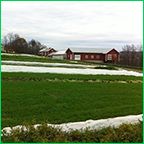
For 25 years, Paul and Sandy Arnold have been building a successful business at Pleasant Valley Farm in Argyle, New York.
They started their farm in 1988, when they were in their late 20s, growing 1 acre of organic vegetables on their 40 acres of land. Since then, they have steadily added and expanded, year after year. They built everything on their farm, including a house with an apartment for interns, a barn with a root cellar, a washing station/packing shed, a radiant heated polycarbonate greenhouse, equipment sheds and three high tunnels. They purchased an additional 20 acres of adjacent land in 1993 and rented a neighbor's 120 acres for additional vegetable production, along with hay production. In the past 6 years, they have installed 30-kW photovoltaic solar systems that provide all the electricity for the farm and house, as well as a solar evacuated tube system to generate domestic hot water.
They did it all without going into debt, other than taking out 10-year mortgages on their land. What's more, both have worked on the farm full time since 1992, and they have homeschooled their two children, Robert, now 20, and Kimberly, 17. They currently grow about 5 acres of vegetables and fruits and sell year-round at farmers' markets and to several local restaurants.
"We were able to accomplish our goal of becoming full-time farmers in a matter of four years and become profitable by using a combination of good business management techniques, good record keeping, season extension and creative marketing," Paul explains. "Profitability to us means each year being able to pay all of our bills, maintain what we have, pay for health insurance, invest money back into the farm, invest in IRAs for us and the kids each year, put money away for retirement, and have a comfortable lifestyle with yearly family vacations."
The Arnolds' financial success and history of innovation has made Pleasant Valley Farm an admired and highly studied market farm. Paul and Sandy are frequent presenters at conferences and they have hosted countless farm tours. They have mentored many apprentices who now run their own farms. One of their goals is to help other farmers become more profitable, whether they are just starting or have years of farming experience.
Greens All Year in Zone 4
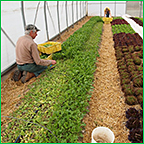
Despite their Zone 4 location an hour north of Albany, New York, the Arnolds are able to grow and sell produce 52 weeks a year. In the winter of 2011–2012, they had two Rimol high tunnels, one 30' x 144' and one 34' x 144', both planted with winter greens. One tunnel was dedicated entirely to spinach and the other had a total of seven beds, consisting of two beds of salad mix lettuce, one bed of mustard greens for salad mix, two beds of Swiss chard, one of kale, and one of arugula. Asian greens are interplanted "French intensive style" between the kale and Swiss chard. Sales from the two tunnels totaled over $50,000 in the period between Thanksgiving and May 1st. Storage crops from their environmentally-controlled root cellar under the barn, heated storage rooms, and low-humidity cooler contributed another $50,000 to their winter sales.
Lettuce is one of their top crops year-round. In the high tunnel, they direct-seed many varieties of lettuce, including many of Johnny's disease-resistant varieties, some which are included in the popular Five Star mix. Their favorite varieties are Sulu, Refugio, Bolsachica, Blade, and Spock for the winter salad mix, but they grow each variety separately. When they grew mixed varieties, they found that green varieties grew faster than reds in winter, and that created extra work at harvest and post harvest, especially if one variety became diseased.
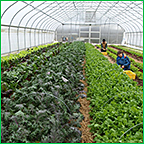
They direct-seed salad mix between October 1st and 15th in the high tunnel, which gives it enough time to get to marketable size before growth slows during the short days of December. Inside the high tunnel, they use hoops over the growing beds and at night cover them with one to three layers of row cover, depending on the temperature. But they try to remove the row covers every day to get more light to the plants.
They begin to harvest salad mix around the second week of January, cutting above the growing point so it will re-grow as the days begin to get longer. They can get up to five cuttings from the high tunnel lettuce, Paul says.
The first week of January, they start salad mix lettuce in multiple-seeded cells, as well as mustards, Asian greens, and Happy Rich (F1) broccoli, which are transplanted into the high tunnel whenever space opens up in March.
As the weather moderates in spring, they switch to field production. In February, they start seeding lettuce for large heads and mini-heads weekly in the greenhouse, which will be transplanted out in the fields as weather permits, starting approximately April 1. Outside, they grow a total of about 1 acre of lettuce each year, consisting of mini heads, which they cut for salad mix or sell for $1 per head, and full-size heads. They don't do direct-seeded baby lettuce for salad mix outside because they have found that mini heads are much less labor-intensive.
"We harvest approximately 90% of our lettuce, and the yield on the lettuce is about $3.90 per square foot if you don't count the 2-foot wide paths, and $2.45 per square foot if you take the paths into consideration," Sandy calculates.
In the last week of July and first week of August, they double the planting of head lettuce, which will mature by November and December. As the temperatures drop, the lettuce hunkers down and its storage life improves. The first time the temperature drops to 10–15°F, they harvest all the lettuce and store it, unwashed, in crates in the root cellar. The head lettuce will store for four to six weeks at 35°F and 98% humidity. When that lettuce is gone, by early January, they start harvesting salad mix from the tunnels, thus completing the annual lettuce cycle.
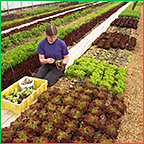
"It has taken us 6 years to perfect this winter lettuce system, because you only have one shot at it per year to get the timing correct for seedings," Paul says.
Their system may be changing, though, after they trialed Salanova® lettuces last summer, fall, and winter. The Salanova varieties grow like head lettuces, but each leaf in the head is a uniform, small size so they can be used as salad mix. Salanova heads are dense, producing many more leaves per square foot than direct-seeded salad mix. They're also downy mildew-resistant, an asset for winter salad mix production.
"Salanova can be harvested at 30 pounds per hour, compared with 10 pounds per hour for baby lettuce," Paul says. "We have to harvest 60 to 70 pounds per week, and I can do that by myself in a couple of hours, thus reducing labor."
The only challenge they had with Salanova was with planting dates for winter production. The lettuce they planted in October in the high tunnel just sat there all winter, and didn't reach harvest size until April.
"What I came to understand is that the timing of when you plant it is going to be more critical," Paul says.
Crop Planning : The '20K/Acre Rule' & the '$30/Hr Rule'
One of the tools the Arnolds use in crop planning is what they call the "$20,000-per-acre rule." They record the square footage, yield, and revenue of every crop they grow, then extrapolate every crop to its revenue per acre. That way, they can compare everything on an equal footing and see which crops make the $20,000 per acre threshold.
High tunnel crops are the most profitable per acre. Spinach, for example, extrapolates to $150,000 per acre. Field-grown lettuce comes in at $106,700 per acre. But many crops are much less valuable. When a crop fails to make $20,000 per acre, the Arnolds have to decide whether to drop it, raise the price, or otherwise tweak production to increase revenue.
"To give an example of how this rule has worked for us, let's examine pea production," Paul and Sandy offer. "In an average year, our records showed the following:
SUGAR SNAP PEAS:
Income = 538 pints @ $3/pint = $1614
Field space = 2700 square feet
1 acre = 43,560 square feet. Therefore, actual acreage planted is 2700/43,560 = 0.062 acre.
Then, we extrapolate to show the value of the crop for 1 acre:
$1614/.062 acre = $26,032 per acre
Using these same formulas and our records, the values of the other peas are calculated as follows:
SHELL PEAS:
$10,337 per acre (at $3 per quart)
SNOW PEAS:
$48,214 per acre (at $3 per pint)
"Thus, we decided to stop growing shell peas, because the market would not bear a high enough price to make it profitable to grow according to our standards and there were no other options available. (We do, however, grow some for ourselves each year, to eat and freeze!) We increased our plantings of sugar snap and snow peas to accommodate what quantities the markets would bear. All numbers will vary by each farmer's spacing, so specific calculations should be done by each farmer to determine his/her most profitable crops."
A second rule of thumb, the "$30-per-hour rule," states that every hour required to pick, wash, and pack a crop must result in at least $30 of revenue. For example, an average worker can harvest 25 pounds of beans per hour, which if sold for $3 per pound would have a value of $75 per hour. Clearly, beans meet the test. Raspberries, in contrast, take much longer to pick. When they were selling raspberries for $2 per half pint, they didn't gross $30 per hour of picking time, so they raised the price to $2.50. Even then, raspberries are just barely over the threshold, so if they were short of time, they ignored the raspberries and got the more profitable crops harvested. In this way, they are able to maximize the profits at every market by having enough of their most valuable crops.
A Word to Young Farmers from Paul & Sandy
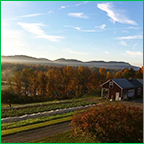
Paul and Sandy have mentored many new farmers over the years, and they always advise them to grow slowly, maintain quality, and stay in control.
"People come here and want what we have, but this is 25 years of accumulation. You can't have it in 5 years … you'll have quite a debt load if you do," Paul says.
Invest first in an irrigation system, he advises. "As a farmer, you're a manager of risk, and your biggest risk is not having water when you need it."
He also believes that marketing should be a market farmer's #1 priority. "I go to market to meet our customers, who have become our friends, and have a good time with them. I don't think about money, the money just comes. That's how you get loyalty from customers."
Next, focus on business management: Where are you making money, and what are your most profitable crops? "When you're culling salad mix or weeding, your mind should be racing away on what you can do better and which techniques or equipment can help accomplish that," Paul suggests. "Conferences, reading lots of publications and books, and visiting other farms are invaluable for making your farm a more profitable business."
Sandy adds that too many beginners try to grow more than they can handle. "We try to grow exactly what we need and not waste it," she says. "We also try to keep our farm neat and organized, so we and our workers can feel proud of it."
The Arnolds maintain a good balance between work and family life. They spend time with their children, who are integrally involved in the farm, and extended family. They take several weeks of vacation every year, often combining travel with speaking engagements.
After 25 years, their enthusiasm for farming is as strong as ever. "It's a great way to make a living," Sandy says.
Learn More
- Some of the information in this article was drawn from the workshop Paul and Sandy presented at the 2010 Maine Organic Farmers & Gardeners/Maine Cooperative Extension 2010 Farmer to Farmer Conference in Northport, Maine:
Building a Profitable Small Farm through Record Keeping, Season Extension, and Winter Growing - Learn more about the Arnolds' approach to year-round production, from their 2012 University of Vermont High Tunnel Conference presentation:
Year-Round High Tunnel Production and Marketing - Follow Pleasant Valley Farm on Facebook.
- Images reproduced with permission from Pleasant Valley Farm. All rights reserved.
- Browse all of Johnny's 40th Anniversary Farm Visits & Grower Profiles


